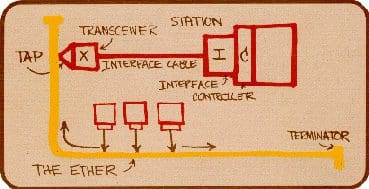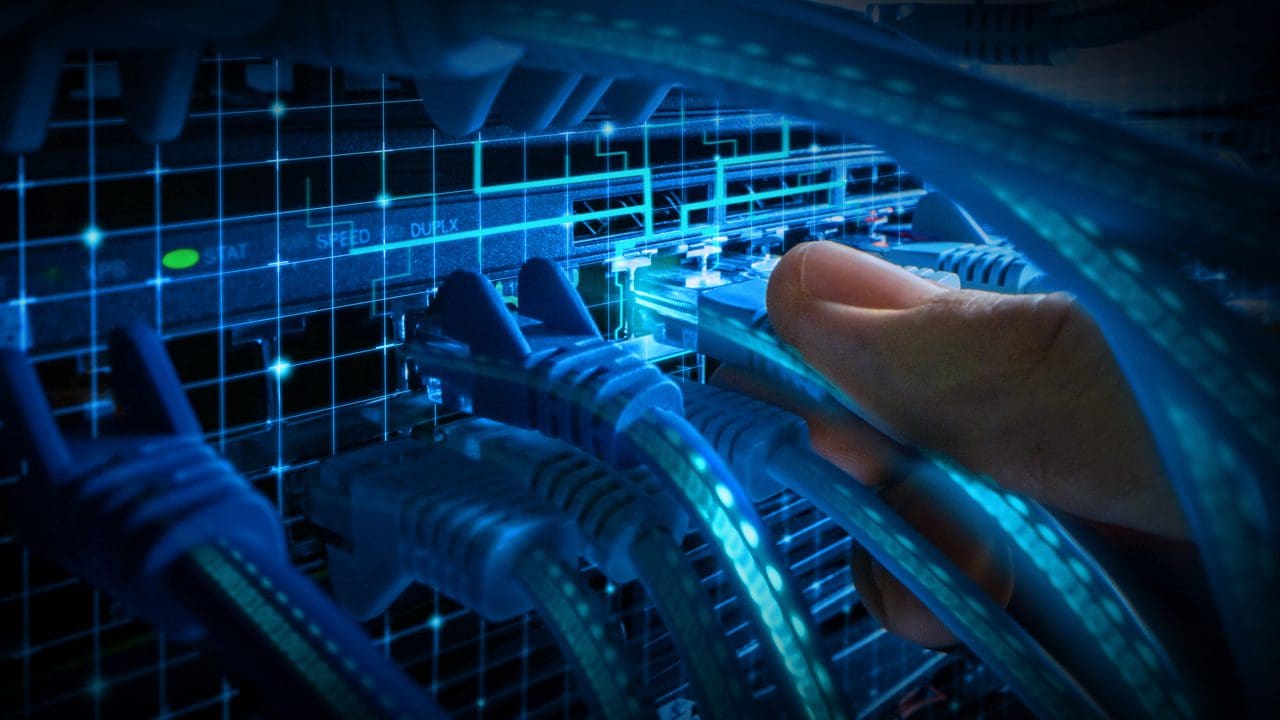Every year provides noteworthy technological innovations, but 1973 was one that stands out. The first personal computer, the Alto by Xerox, was developed and introduced the Graphical User Interface (GUI) and included a mouse. The first handheld cellular phone call, on a unit weighing about 1.134kg (2.5lbs), was made by Motorola’s Martin Cooper to Joel Engel of Bell Labs. Two scientists at the Defense Advanced Research Projects Agency (DARPA) created the next generation Transmission Control Protocol (TCP), the standard protocol used on the Internet today.
The Ethernet was Born
At first, Ethernet simply enabled the task of connecting computers to one another and to shared printers. This was no small feat, as computers once “talked” to each other using painfully slow modems, with one computer “calling” another, that transmitted data at speeds that users in 2023 would regard as glacial.
Today, most of us take the Ethernet for granted; it was invented before many people who are reading this sentence were born. Scientists and users alike are accustomed to the idea that more and more devices should be connected—and faster. Ethernet, over its five decades of continuous development, delivers what people want.
Ethernet has become the standard for local area networking (LAN) and is now widely used in businesses, homes, and other environments. Its development has enabled reliable, high-speed communication among computers and other devices, allowing them to share information and resources with each other and connect to the Internet.
Ethernet’s success has been supported by the IEEE 802.3™ standards, which provide a framework for the technology. This framework has made Ethernet ubiquitous, accessible, affordable, and fast, all while driving innovation and progress for the technology.
As Ethernet celebrates its 50th anniversary, join us on this walk down memory lane to explore how the IEEE 802.3 series of standards has influenced the evolution of the technology through the decades.
The Early Days of Ethernet
Ethernet, a networking technology that impacts lives across the globe daily, was invented at Xerox’s Palo Alto Research Center (PARC) in 1973 by Robert Metcalfe. Metcalfe was challenged to build a networking system for Xerox’s computers, and he developed Ethernet through a memo he wrote to the company’s leadership describing how the technology worked and its promising potential. This system allowed computers to share files and printers, which was a significant milestone for the time. Years later, Ethernet would go on to support the Internet and become the most widely used networking technology in the world.

Ethernet gained momentum in the 1980s as it continued to evolve and gain popularity. In this decade, Ethernet emerged as the industry standard for LAN, marking a significant turning point for this technology. In June 1983, Ethernet was adopted as an IEEE standard by the IEEE 802 Local Area Network Standards Committee. This move aimed to provide a unified framework for its implementation. The committee’s efforts were instrumental in establishing Ethernet as a widely adopted and standardized technology.
Substantial changes came in the mid-1990s with the introduction of 10BASE-T and then, very rapidly, Ethernet switched from shared media Ethernet to full duplex Ethernet in 1997. Up to this point, Ethernet was a complex of snaking cables in ceilings—and then the Internet and telecom providers happened.
Moving into telecom markets, Ethernet spurred a series of new speeds and parallelism while also becoming a power distribution technology due to telephony’s need to power connected devices. More needs, challenges, and solutions continued till present day.
Throughout its evolution, Ethernet was largely driven by market needs, then speed became key. For perspective, only six speed increases occurred in about 35 years; later, six speed increases were introduced in about five years. Standards development saw six speeds of Ethernet added to IEEE 802.3 in the first 30 years, raising the speed to 100 Gb/s in 2013, but in just five more years another six speeds were added to IEEE 802.3, taking the maximum speed to 400 Gb/s in 2018. And this continues, with work underway to add 800 Gb/s and 1.6 Tb/s Ethernet. Thus, the last half of Ethernet’s 50-year history experienced three times the amount of growth than the first 25 years.
IEEE Standards for Ethernet
With the emergence of the Internet, the dot-com bubble, streaming, and the Internet of Things, the constant need for connectivity, speed, and accessibility have become major factors in networking. As industry needs evolved, so did the technology around Ethernet. Since its inception, many standards have been drafted and ratified, including:
- IEEE 802.3: The original standard given for 10BASE-5. It used a thick single coaxial cable into which a connection can be tapped by drilling into the cable to the core. Here, 10 is the maximum throughput, i.e., 10 b/s, BASE denotes use of baseband transmission, and 5 refers to the maximum segment length of 500m. Since the original standards was completed, new technologies have been added to IEEE 802.3, as amendments. Some key ones are identified below by their amendment name (802.3a, etc.) but are now considered part of the larger IEEE 802.3 with well over 200 clauses and annexes.
- IEEE 802.3a: This revision brought the standard for less expensive coax (10BASE-2), which is a thinner variety where the segments of coaxial cables are connected by BNC connectors. The 2 refers to the maximum segment length of about 200m (185m, precisely).
- IEEE 802.3i: This gave the standard for twisted pair (10BASE-T) that uses unshielded twisted pair (UTP) copper wires as physical layer medium. The further variations were given by IEEE 802.3u for 100BASE-TX, 100BASE-T4, and 100BASE-FX.
- IEEE 802.3j: This gave the standard for Ethernet over Fiber (10BASE-F) that uses fiber optic cables as a medium of transmission.
- IEEE 802.3u Fast Ethernet: introduced 100 Mbps Ethernet, which was a significant improvement over the original Ethernet standard. Fast Ethernet is still widely used today.
- IEEE 802.3ab Gigabit Ethernet: introduced 1 Gbps Ethernet, which was a major advancement in Ethernet technology. It allowed for faster data transfer and supported new applications like video streaming and cloud computing.
- IEEE 802.3ae 10 Gigabit Ethernet: introduced 10 Gbps Ethernet, a milestone technology. It supported even faster data transfer and helped to pave the way for new applications like virtualization and high-performance computing.
- IEEE 802.3an 10GBASE-T: introduced 10 Gbps Ethernet over twisted-pair copper cabling. It made 10 Gbps Ethernet more accessible and affordable for businesses and homes.
- IEEE 802.3bz 2.5GBASE-T and 5GBASE-T: introduced intermediate speeds between 1 Gbps and 10 Gbps, which are useful for supporting emerging applications like 4K video streaming and virtual reality.
- IEEE 802.3ba 40 Gigabit and 100 Gigabit Ethernet: introduced two new Ethernet speeds, a milestone breaking the “10X the speed” progression of Ethernet.
- IEEE 802.3bs 200 Gigabit and 400 Gigabit Ethernet: continues to expand Ethernet to highest speeds standardized today.
- IEEE 802.3af Power over Ethernet: Introduced power over the same wires used for Ethernet, an important application for expanding Ethernet into roles in operational technology.
- IEEE 802.3bp (1 Gbps) and IEEE 802.3bw (100 Mbps) Automotive Ethernet: Introduced single-pair Ethernet links optimized for use in automobiles.
- IEEE 802.3cg 10 Mbps single-pair Ethernet: Introduced specialized Ethernet optimized for industrial and building automation, and intrasystem applications, which are useful in operational technology applications.
These standards have all played a significant role in the development and advancement of Ethernet technology, and they continue to be relevant and important today.
Looking to the Future
Through the decades, Ethernet has proliferated in various fields, powering data centers, enterprise networks, consumer devices, vehicles, and the Internet of Things, like no other technology of our time. Ethernet specialization in automotive and manufacturing, among other industries, is at the forefront of innovation today. As Ethernet marks its 50th anniversary, IEEE 802.3 standards continue to play a crucial role in shaping and advancing the future of Ethernet and networking technology.
How IEEE SA Supports the Development and Launch of Ethernet Standards
Through our IEEE 802 LAN/MAN Standards Committee, IEEE SA develops and maintains networking standards and recommended practices for local, metropolitan, and other area networks. As Ethernet LAN technology continues to progress on multiple fronts, so will IEEE Standards, to help to bring out the full potential of Ethernet technology and serve the future industry and society needs.
When we celebrate the 50th anniversary of the Ethernet, we also pay homage to and thank the global network of thousands of IEEE SA volunteers who have researched, debated, and achieved consensus time and again. We welcome the involvement of participants from academia, government, and industry. For more information or to join the standards activity, please visit the IEEE 802 LAN/MAN Standards Committee webpage.








